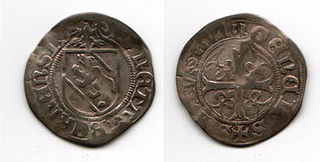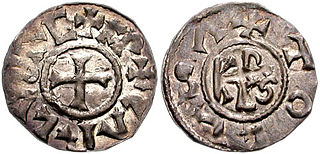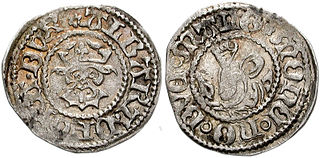
The shilling is a historical coin, and the name of a unit of modern currencies formerly used in the United Kingdom, Australia, New Zealand, other British Commonwealth countries and Ireland, where they were generally equivalent to 12 pence or one-twentieth of a pound before being phased out during the 20th century.

The mark was a currency or unit of account in many states. It is named for the mark unit of weight. The word mark comes from a merging of three Teutonic/Germanic words, Latinised in 9th-century post-classical Latin as marca, marcha, marha or marcus. It was a measure of weight mainly for gold and silver, commonly used throughout Europe and often equivalent to 8 troy ounces (250 g). Considerable variations, however, occurred throughout the Middle Ages.

A bracteate is a flat, thin, single-sided gold medal worn as jewelry that was produced in Northern Europe predominantly during the Migration Period of the Germanic Iron Age. Bracteate coins are also known from the medieval kingdoms around the Bay of Bengal such as Harikela and Mon city-states. The term is also used for thin discs, especially in gold, to be sewn onto clothing in the ancient world, as found for example in the ancient Persian Oxus treasure, and also later silver coins produced in central Europe during the Early Middle Ages.

The pfennig or penny is a former German coin or note, which was the official currency from the 9th century until the introduction of the euro in 2002. While a valuable coin during the Middle Ages, it lost its value through the years and was the minor coin of the Mark currencies in the German Reich, West and East Germany, and the reunified Germany until the introduction of the euro. Pfennig was also the name of the subunit of the Danzig mark (1922–1923) and the Danzig gulden (1923–1939) in the Free City of Danzig.

The batzen is an historical Swiss, south German and Austrian coin. It was first produced in Berne, Switzerland, from 1492 and continued in use there until the mid-19th century.

Groschen a name for various coins, especially a silver coin used in various states of the Holy Roman Empire and other parts of Europe. The word is borrowed from the late Latin description of a tornose, a grossus denarius Turnosus, in English the "thick denarius of Tours". Groschen was frequently abbreviated in old documents to gl, whereby the second letter was not an l, but an abbreviation symbol; later it was written as Gr or g.

The German mark was the currency of the German Empire, which spanned from 1871 to 1918. The mark was paired with the minor unit of the pfennig (₰); 100 pfennigs were equivalent to 1 mark. The mark was on the gold standard from 1871–1914, but like most nations during World War I, the German Empire removed the gold backing in August 1914, and gold and silver coins ceased to circulate.

The Heller, abbreviation hlr, was a coin, originally valued at half a pfennig, that was issued in Switzerland and states of the Holy Roman Empire, surviving in some European countries until the 20th century.

The history of Saxon coinage or Meissen-Saxon coinage comprises three major periods: the high medieval regional Pfennig period, the late medieval Pfennig period and the Thaler period, which ended with the introduction of the Mark in 1871/72. Rich silver deposits, which were discovered near Freiberg after the middle of the 12th century, helped Saxony to a leading position in German coinage.

The Sachsenpfennig, sometimes called the Wendenpfennig or the Hochrandpfennig was a well-known coin of the pfennig type minted in the eastern part of the Stem Duchy of Saxony during the 10th and 11th centuries. It had an upturned perimeter and, next to the Otto Adelheid Pfennig was the most common pfennig type of its time. Sachsenpfennigs are the oldest coins minted in Saxony. Its different names represent a lack of clarity within mediaeval numismatics about the coin.
A Großpfennig or Großer Pfennig was a Pomeranian pfennig coin of the 14th and 15th centuries. It also referred, in a more general sense, to any coin whose value was a multiple of the pfennig.

From the Late Middle Ages the albus was a common currency in parts of the Holy Roman Empire, especially in the Rhineland. The name albus is Latin and means "white". Because of its higher silver content, this lighter coin differed in colour from the other inferior coins. This resulted in the names denarius albus, Weißpfennig or Rhenish groschen.

The schilling was the name of a coin in various historical European states and which gave its name to the English shilling. The schilling was a former currency in many of the German-speaking states of the Holy Roman Empire, including the Hanseatic city states of Hamburg and Lübeck, the March of Brandenburg, and the Duchies of Bavaria, Mecklenburg, and Württemberg. It was also used in Switzerland and in Austria, where silver schillings were introduced as recently as 1923.

The Carolingian monetary system, also called the Carolingian coinage system or just the Carolingian system, was a currency structure introduced by Charlemagne in the late 8th century as part of a major reform, the effects of which subsequently dominated much of Europe, including Britain, for centuries. It is characterised by having three denominations in the ratio 1:20:240, the units of which went under different names in the different languages, but which corresponded to the Latin terms libra (pound), solidus (shilling) and denarius (penny).
The Carolingian pound, also called Charlemagne's pound or the Charlemagne pound, was a unit of weight that emerged during the reign of Charlemagne. It served both as a trading weight and a coinage weight. It had a mass of about 408 g and was introduced in as part of Charlemagne's monetary reform around AD 793/94. This stipulated that 240 denarii were to be minted from one pound weight of silver.

The Wendish Coinage Union was an organisation bound by treaty formed by the North German Hanseatic towns from 1379 to the 16th century whose aim was to have standardised coinage regulations.

Dreiling was the name of a type of fiat coin called a Scheidemünze that was worth three pfennigs.

The Sechsling, also Sößling, Søsling (Dan./Norw.) or Sechser, was the name of a type of coin with a value of six Pfennigs, representing half a Groschen or half Schilling depending on the monetary system.

The Wendenthaler or Wendentaler was a currency coin minted in Lüneburg from 1541, which depicted the six coats of arms of the Wendish towns.
The Blaffert was the name of two different types of historical European coin. It was also called the Blafferd or, in Upper German, the Plappart, Plappert or Blaphart. It derives from the French blafard meaning "pale" or "bright".


















